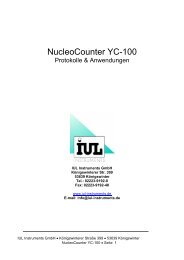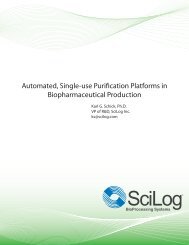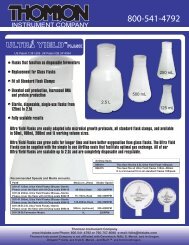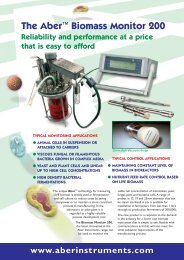Transia Plate Gluten - IUL Instruments GmbH
Transia Plate Gluten - IUL Instruments GmbH
Transia Plate Gluten - IUL Instruments GmbH
Create successful ePaper yourself
Turn your PDF publications into a flip-book with our unique Google optimized e-Paper software.
<strong>Transia</strong> <strong>Plate</strong><br />
<strong>Gluten</strong><br />
Result interpretation -<br />
semi-quantitative assay<br />
Validation of the test<br />
The mean optical density (OD) of the negative controls<br />
must be lower than 0.15. If not, the results are<br />
not valid. Repeat the ELISA, taking extra care that all<br />
the reagents are at room temperature and that the<br />
washing step is performed correctly.<br />
<strong>Gluten</strong> content<br />
As defined by the Codex Alimentarius Commission in<br />
1981 (Codex Standard for “<strong>Gluten</strong>-free” Foods, STAN<br />
118-198, Food Agriculture Organisation/World Health<br />
Organisation, Rome, Italy), products labelled glutenfree<br />
may not contain more than 200 ppm (0.02%)<br />
gluten.<br />
Compare the mean OD of the sample with the mean<br />
OD of the reference starches.<br />
If the OD of the sample diluted 1/50 is lower than the<br />
OD of starch A then the product may be labelled<br />
“gluten-free”.<br />
If the OD of the sample diluted 1/50 is higher than<br />
the OD of starch A, but the OD of the sample diluted<br />
1/250 is lower than the OD of starch B, then the<br />
gluten level should be measured quantitatively to<br />
determine if the product could be labelled “glutenfree”<br />
or not.<br />
If the OD of the sample diluted 1/250 is higher than<br />
the OD of starch B, but the OD of the sample diluted<br />
1/1,000 is lower than the OD of starch C, then the<br />
label “gluten-free” is not acceptable.<br />
If the OD of the sample diluted 1/1,000 is higher than<br />
the OD of starch C then the label “gluten-free” is not<br />
acceptable.<br />
Result interpretation -<br />
quantitative assay<br />
Validation of the test<br />
The mean OD of the negative controls must be lower<br />
than 0.15.<br />
The standards must meet the following requirements:<br />
Dilution Standard OD<br />
3 0.20 µg/mL ≥ 0.800<br />
4 0.16 µg/mL ≥ 0.650<br />
5 0.08 µg/mL ≥ 0.350<br />
6 0.04 µg/mL ≥ 0.200<br />
7 0.02 µg/mL ≥ 0.100<br />
8 0.01 µg/mL ≥ 0.070<br />
If the standards do not meet the requirements, repeat<br />
the ELISA, taking extra care that all reagents are at<br />
room temperature and that the washing step is performed<br />
correctly.<br />
<strong>Gluten</strong> content<br />
Using a lin-lin graph paper, draw a standard curve<br />
with the OD of the standards on the y-axis and the<br />
concentration [µg/mL] on the x-axis. An example of a<br />
standard curve is given in Appendix B.<br />
Plot the mean OD of the chosen sample dilution on<br />
the standard curve. Read the gliadin concentration<br />
(G) of the sample dilution.<br />
Note the gliadin concentration on the work sheet<br />
(ENR COM 113) and calculate the gluten content by<br />
using the following equation.<br />
% gluten = G x D x 2 x 10 /10,000<br />
G = gliadin concentration read from the standard<br />
curve<br />
D = dilution factor of the extract (e.g. 50, 250…)<br />
Factor 2 ⇒ it is estimated that 50% of the protein in<br />
gluten is in the form of gliadin.<br />
Factor 10 ⇒ 10 mL of extraction solution is used for<br />
1g of sample<br />
Factor 10,000 ⇒ converts the concentration from<br />
µg/g into %<br />
See Appendix A for conversion from % to ppm.<br />
NOT COM 111E 11/00<br />
6 (8)









